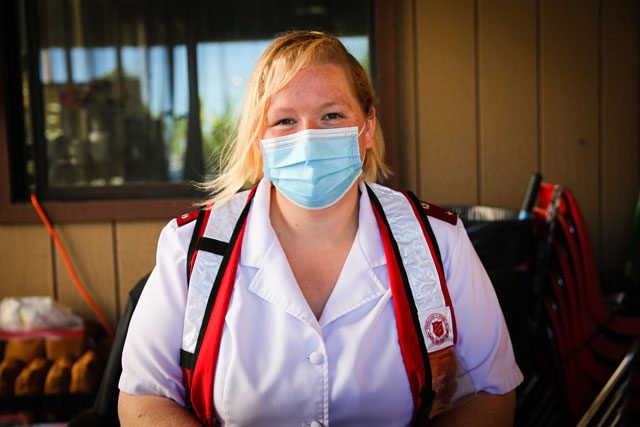By Hillary Jackson –
For many frontline workers, The Salvation Army’s free childcare program at several of the Western Territory’s Ray and Joan Kroc Corps Community Center facilities is a godsend. Despite the continued need for childcare as COVID-19 stretches on, the Kroc Center programs nearly met an untimely end due to funding—but AT&T came forward to fill the gap.
AT&T partnered earlier in the pandemic to support the childcare programs for frontline workers, and provided additional funds for the territory to continue the vital services through the end of May.
The additional funding from AT&T will support the childcare programs at the Salem (Oregon), Suisun City (California) and San Diego Kroc Centers. The gift, totaling $87,920, comes from AT&T’s state teams in Oregon and California, but is part of the relationship The Salvation Army has through AT&T’s $500,000 national contribution to the Army’s COVID-19 relief efforts serving frontline workers.
“AT&T has been an incredible partner to The Salvation Army since the start of the COVID-19 crisis and their commitment to keep these programs going so that frontline workers don’t have to worry about their children while they care for our communities is a beautiful thing,” said Territorial Director of Corporate Engagement Maria Todaro.
At the beginning of the pandemic, The Salvation Army offered all of its facilities in the West to officials for public use. As the need for childcare for frontline workers became apparent, along with the need for a proper space and personnel to run a childcare program, the Army had a clear solution: its Kroc Centers.
“This program has enabled the Kroc Centers to leverage their unique facilities and expertise to meet a significant need for many essential workers and their families,” said Assistant Secretary for Business Administration Steve Bireley. “Without the AT&T funding, we would be unable to provide this valuable service to families in the Salem, San Diego and Suisun City communities.”
The Salem Kroc Center is the largest childcare program of the three centers, with 83 children enrolled. Before the latest gift from AT&T, the center had exhausted funds quickly and wasn’t sure how it would be able to continue to offer the program that remains needed by the community.
“In the conversations we have had with parents, they are eternally grateful. When schools were shut down, many of them didn’t have options. They didn’t know what to do or where to turn. They were relieved when they heard about our emergency childcare program and were shocked that we could offer a quality program in a first-class facility for free,” said Salem Kroc Center Corps Officer Lt. Quinton Markham. “Many of them never imagined they would need assistance from The Salvation Army. The generous gift from AT&T made all of this possible.”
The funding also comes at a good time for the Suisun City Kroc Center, where 27 children have enrolled in childcare.
“It is no longer business as usual as far as how we function as a center,” said Director of Operations Michael Brito. “There is no clear time when the program will end and we are so thankful for the funding that we have received and we would like to tell people that we still need their help in the foreseeable future so we can continue to provide this program to the community.”
The center has received glowing reviews from parents who appreciate the procedures staff have put in place to make sure their children are being taken care of, as well as how happy their children are when they are picked up at the end of the day.
“The Kroc Suisun is amazing,” said Erika Taylor, whose child participates in the program. “They have been providing a clean and safe environment for my child while I am on the frontline of COVID-19. He has a sense of normalcy and educational stimulation as well. My family loves the staff here. It’s like we’re family because we are going through this together. I don’t know what I would have done without this place.”
When those at the San Diego Kroc Center found out they were one of the recipients of the grant from AT&T, they partnered with Sharp Hospitals, which e-blasted its 14,000 staff—the center’s camps were filled within hours. Currently, the San Diego Kroc Center has 45 children enrolled.
“Working in hospitals is extremely stressful during normal times, but during this crisis that stress is magnified,” said San Diego Kroc Center Director Clarissa Glasco. “Add on to that work stress, the elevated home stress of navigating how you are going to provide your child safe and nurturing childcare and a virtual education. Through the funding from AT&T, The Salvation Army Kroc Center was able to reduce that stress by serving their children’s physical, emotional and educational needs with virtual education.”
Glasco noted how this summer will look a lot different than other years, and that the center is actively working on plans to reopen in waves, following state and local guidelines.
“In spite of the challenges, Kroc Centers are providing an environment that is fun, enriching and most of all, safe for children and staff,” Bireley said. “The program this funding supports also provides steady employment for many people who might not otherwise have meaningful work.”
HOW TO HELP:
- If you’d like to make a monetary donation, please click here to make a gift.
- Text ‘GIVE’ to 52000 to make a $10 donation to The Salvation Army. This will automatically add a one-time donation to your next mobile phone bill.
- For information about volunteering, please visit volunteer.usawest.org.
- To learn more about how to support The Salvation Army’s relief efforts, please click here.










